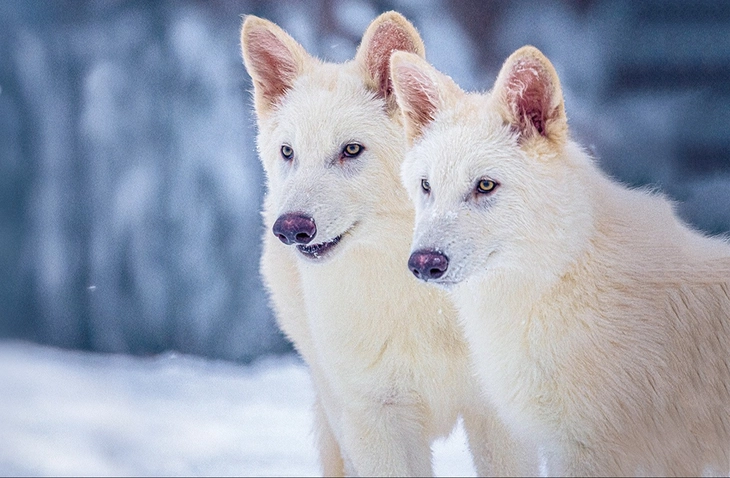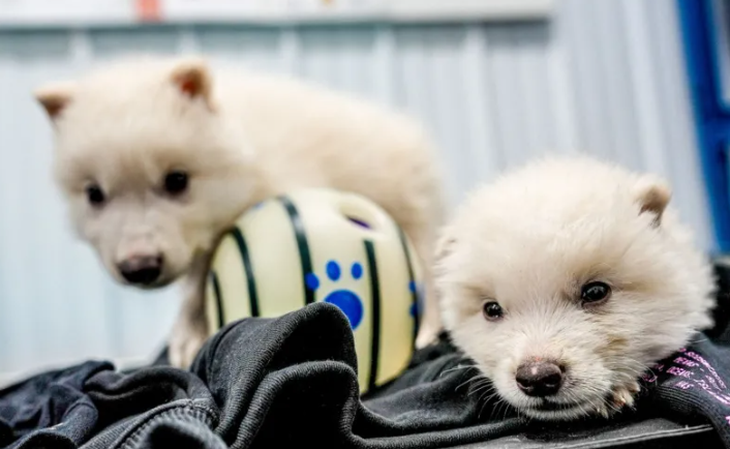
Two wolves Romulus and Remus were born thanks to genetic modification technology - Photo: Colossal Biosciences
On April 7, the biotechnology company Colossal (Dallas, USA) announced that it had revived a wolf species that had been extinct for about 12,500 years. Colossal asserted that this was the first successful revival of an animal that had been completely genetically extinct.
While the company sees this as an impressive technological breakthrough, many experts say these new wolves are not the same ferocious wolves that have existed since prehistoric times.
"Revival" technology
Scientists have successfully created three wolf pups (Romulus, Remus and Khaleesi) using ancient DNA technology, then cloned and edited the genes of a gray wolf - the closest living relative of prehistoric wolves.
The result is a hybrid species that resembles its extinct ancestor, the dire wolf Aenocyon dirus - once the top predator in North America.
This resurrection process requires scientists to analyze ancient DNA to identify key mutations that made the extinct species different from its living relatives.
They then edit the DNA of the current species and use this genetic code to create individuals that have the characteristics of the extinct species, although they are not genetically identical.
Remarkably, just a few small genetic changes can make the difference between a living species and an extinct one. The average wolf has about 19,000 genes.
Colossal made about 20 tweaks in 14 key genes of the modern gray wolf to match those of the prehistoric wolf, including white fur, larger teeth and jaws, stronger shoulders and legs, and changes in howl, according to Time magazine.
The New York Times quoted geneticist Adam Boyko at Cornell University (USA) as saying that creating new hybrid species with characteristics of extinct species is interesting. However, he does not think Romulus, Remus and Khaleesi are purebred prehistoric wolves.
Additionally, they do not develop in packs in the wild, do not hunt instinctively, and do not have the characteristic gut microbiota of their ancestors.
Scientific debate

Two wolves Romulus and Remus at 1 month old - Photo: Colossal Biosciences
Many scientists have pointed out the difference between the newly recovered wolf species and the fierce predatory wolf that has become extinct. Zoologist Philip Seddon from the University of Otago (New Zealand) said that these wolves are just "genetically modified gray wolves".
Associate professor and co-director of the Paleogenetics Laboratory Nic Rawlence from the University of Otago said that the DNA of ancient wolf species found from fossils was too damaged and decomposed, making biological copying and cloning almost impossible, according to BBC.
"Ancient DNA is replicated in the same way that if you put new DNA in a 500-degree oven overnight, it will come out as fragments, like debris and dust. You can replicate it, but it's not of good enough quality to do anything more," he argues.
Dr Rawlence explained that Colossal used new biotechnology - using ancient DNA to identify key genetic codes, then inserting that genetic information into the structure of the gray wolf. Therefore, the new wolf is still a gray wolf but has the characteristics of the prehistoric wolf - a hybrid.
Director of the Australian Ancient DNA Centre Jeremy Austin also said that even if successful, this revival still has many questions because species of the Canidae family in nature have very similar shapes. Determining the exact external characteristics of extinct species from fossils is very difficult, according to ScienceAlert magazine.
In addition, many experts criticized Colossal's claim that this is the world's first revived species. Previously, in 2003, scientists in Spain cloned an extinct wild goat species called bucardo or Pyrene mountain goat, according to the Live Science information page.
On the other hand, some scientists are optimistic about Colossal's achievement. They consider the new wolf hybrid to represent advances in genetic technology, opening up potential applications for the conservation of existing species, such as the red wolf in North Carolina (USA).
Applications in species conservation
On April 7, Colossal also announced that it had successfully cloned four red wolves. This is an endangered species with very few remaining. They are facing a lack of genetic diversity, leading to infertility or birth defects. DNA technology can help with this problem, according to Colossal.
Source: https://tuoitre.vn/tranh-cai-ve-hoi-sinh-dong-vat-tuyet-chung-20250411071947936.htm


![[Photo] General Secretary To Lam receives US Ambassador to Vietnam Marc Knapper](https://vphoto.vietnam.vn/thumb/1200x675/vietnam/resource/IMAGE/2025/9/29/c8fd0761aa184da7814aee57d87c49b3)
![[Photo] Solemn opening of the 12th Military Party Congress for the 2025-2030 term](https://vphoto.vietnam.vn/thumb/1200x675/vietnam/resource/IMAGE/2025/9/30/2cd383b3130d41a1a4b5ace0d5eb989d)
![[Photo] General Secretary To Lam, Secretary of the Central Military Commission attends the 12th Party Congress of the Army](https://vphoto.vietnam.vn/thumb/1200x675/vietnam/resource/IMAGE/2025/9/30/9b63aaa37ddb472ead84e3870a8ae825)
![[Photo] General Secretary To Lam attends the ceremony to celebrate the 80th anniversary of the post and telecommunications sector and the 66th anniversary of the science and technology sector.](https://vphoto.vietnam.vn/thumb/1200x675/vietnam/resource/IMAGE/2025/9/29/8e86b39b8fe44121a2b14a031f4cef46)




















![[Photo] Many streets in Hanoi were flooded due to the effects of storm Bualoi](https://vphoto.vietnam.vn/thumb/1200x675/vietnam/resource/IMAGE/2025/9/29/18b658aa0fa2495c927ade4bbe0096df)
![[Photo] National Assembly Chairman Tran Thanh Man chairs the 8th Conference of full-time National Assembly deputies](https://vphoto.vietnam.vn/thumb/1200x675/vietnam/resource/IMAGE/2025/9/29/2c21459bc38d44ffaacd679ab9a0477c)

































































Comment (0)